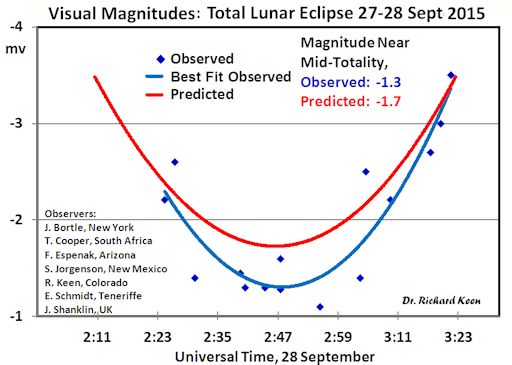Atmospheric scientist Richard Keen of the University of Colorado explains: "Lunar eclipses tell us a lot about the transparency of Earth's atmosphere. When the stratosphere is clogged with volcanic ash and other aerosols, lunar eclipses tend to be dark red. On the other hand, when the stratosphere is relatively clear, lunar eclipses are bright orange."
This is important because the stratosphere affects climate; a clear stratosphere 'lets the sunshine in' to warm the Earth below. At a 2008 SORCE conference Keen reported that "The lunar eclipse record indicates a clear stratosphere over the past decade, and that this has contributed about 0.2 degrees to recent warming."
The eclipse of Sept. 27, 2015, however, was not as bright as recent eclipses. Trained observers in 7 countries estimated that the eclipse was about 0.4 magnitude dimmer than expected, a brightness reduction of about 33 percent.

What happened? "There is a layer of volcanic aerosols in the lower stratosphere," says Steve Albers of NOAA. "It comes from Chile's Calbuco volcano, which erupted in April 2015. Six months later, we are still seeing the effects of this material on sunsets in both hemispheres--and it appears to have affected the eclipse as well."
Volcanic dust in the stratosphere tends to reflect sunlight, thus cooling the Earth below. "In terms of climate, Calbuco's optical thickness of 0.01 corresponds to a 'climate forcing' of 0.2 Watts/m2, or a global cooling of 0.04 degrees C," says Keen, who emphasizes that this is a very small amount of cooling. For comparison, the eruption of Pinatubo in 1991 produced 0.6 C of cooling and rare July snows at Keen's mountain home in Colorado.
"I do not anticipate a 'year without a summer' from this one!" he says. "It will probably be completely overwhelmed by the warming effects of El Nino now underway in the Pacific."
This lunar eclipse has allowed Keen measure the smallest amount of volcanic exhaust, and the smallest amount of resultant "global cooling" of all his measurements to date. And that is saying something considering that he has beenmonitoring lunar eclipses for decades.
"This is indeed the smallest volcanic eruption I've ever detected," says Keen. "It gives me a better idea of the detection capabilities of the system (eclipses plus human observers), so when I go back into the 1800s I can hope to find similarly smallish eruptions in the historical record."
Bron:http://www.spaceweather.com/ | Gewijzigd: 31 januari 2017, 14:07 uur, door Joyce.s

 Lunar eclipse detects global cooling (but only a little)
Lunar eclipse detects global cooling (but only a little)




